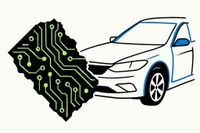Chinese electric vehicle (EV) makers are surging into the European market, shaking up an industry long dominated by legacy manufacturers and sending ripples through the continent’s sprawling automotive supply chain. Their arrival is not only reshaping the competitive landscape for carmakers but is also having a profound impact on the tech suppliers and partners that power Europe’s auto sector.
On August 9, 2025, it was reported that Chinese EV brands such as Zeekr—a premium marque owned by Geely—have already established footholds in several European countries and are eyeing further expansion, including a planned entry into the UK within the next two years. Zeekr’s strategy hinges on highly automated plants, vertical integration, and proprietary battery and software technology, all of which allow it to deliver cars that are cheaper, quicker to market, and technologically advanced compared to many European rivals.
Europe’s traditional carmakers, including Jaguar Land Rover, Nissan, Volkswagen, and Renault, are scrambling to retool for an electric future. But as Professor Peter Wells, director of the Centre for Automotive Industry Research at Cardiff University, told The Guardian, “Chinese firms are nimble, fast and technologically advanced—especially in software, where European firms have struggled.” With the UK and EU mandating that all new cars sold by 2035 must be zero-emission, the pressure to adapt has never been higher.
The numbers underscore the shifting tides. In 2024, Europe registered almost two million fully electric cars, a sign that the transition to EVs is well underway. Yet, persistent challenges remain: high prices, patchy charging infrastructure, and consumer hesitation continue to dampen widespread adoption. Meanwhile, analysts warn that European manufacturers are about a decade behind China in production capacity and, crucially, in the supply chain control of vital battery minerals.
Andy Palmer, former Aston Martin CEO and ex-Nissan executive, offered a candid assessment: “Tariffs insulate the baby, so the baby never learns to walk. The price of entry for Chinese brands should be localisation—build here, employ here, invest here.” Palmer pointed to Nissan’s Sunderland plant as evidence that local manufacturing can foster robust automotive ecosystems and argued, “The UK has clout as Europe’s second-largest EV market. We should use it.”
Chinese EV makers have zeroed in on compact, efficient, and affordable models—like Nio’s soon-to-launch Firefly—while European brands have focused on larger, pricier SUVs. Professor Wells warns that this mismatch could see the mass market slip from the grasp of Europe’s legacy carmakers, with Chinese rivals swooping in to fill the gap.
In response to the growing threat, the European Union has levied tariffs of up to 45% on some Chinese EV imports. But the move has exposed deep divisions among member states. Germany, whose own car industry is heavily reliant on exports to China, fears retaliation, while France and Italy have pushed for even stronger trade barriers. Chinese firms, for their part, are already seeking ways to sidestep these tariffs, including shifting production to countries like Turkey.
Despite these trade tensions, analysts believe that blocking Chinese EVs at the border is not a long-term solution. As Al Bedwell at GlobalData told Reuters, Chinese brands are likely to capture around 15% of Europe’s all-electric market by the mid-2030s—a significant share, but “not an existential threat.” Bedwell explained, “Europe can’t compete on cost, but it has brand recognition, dealer networks and after-sales service that take time to build. Some Chinese brands have entered markets without understanding local customer preferences.”
Partnerships are already forming as both sides look for ways to navigate the new landscape. Stellantis, the parent company of Peugeot and Fiat, has invested in Chinese EV startup Leapmotor, while German giants BMW and Audi have inked joint projects with Chinese firms. Felipe Munoz, an automotive analyst in Turin, summed up Europe’s predicament: “These rules were designed when China wasn’t a player. We need lower taxes, less red tape and more R&D incentives.”
The rapid rise of Chinese EVs is also reverberating through the wider automotive ecosystem, with tech suppliers feeling the pinch. On August 6, 2025, Finnish software maker Qt Group reported quarterly revenue of €51.2 million ($59.3 million), falling short of analyst expectations. The company’s shares tumbled 15% to an 18-month low, a slump attributed in large part to headwinds in its automotive software business. Clients such as Mercedes-Benz, Hyundai, Kia, and Peugeot have all scaled back spending amid industry slowdowns and intensifying competition from Chinese manufacturers.
Qt Group’s CEO cited the rise of Chinese competitors as a fresh concern for Western suppliers. The company hasn’t changed its full-year forecast yet, but analysts warn that if demand fails to rebound, another profit warning could be on the horizon. The story is similar across the sector: Kongsberg Automotive is cutting costs, Mercedes-Benz has lowered its outlook, and BMW has reported weaker profits. Even as tariffs between Europe and the US have eased, automakers continue to grapple with global export hurdles and shifting consumer demand.
These developments highlight how deeply intertwined international trade, industrial demand, and corporate profits have become. The pace of recovery for automakers—and their suppliers—could well set the tone for Europe’s broader technology and manufacturing landscape in the years ahead.
As the battle for Europe’s roads intensifies, industry leaders are calling for a fundamental reset. Palmer, for example, remains cautiously optimistic: “We have a once-in-a-generation chance to reset Europe’s automotive industry. If we act wisely—and quickly—Europe can still lead in EVs. If we rely on tariffs and delay tough decisions, we’ll face terminal decline.”
For now, the race is on. Chinese EV makers are moving fast, leveraging their technological edge and supply chain mastery. European manufacturers and their suppliers are under mounting pressure to innovate, form new alliances, and adapt to a market that is changing at breakneck speed. Whether Europe can rise to the challenge—or risk being left behind—remains the question on everyone’s mind in the industry.
Ultimately, the next decade will reveal whether Europe’s storied automotive sector can reinvent itself or if the future of driving on the continent will be shaped by newcomers from the East.




